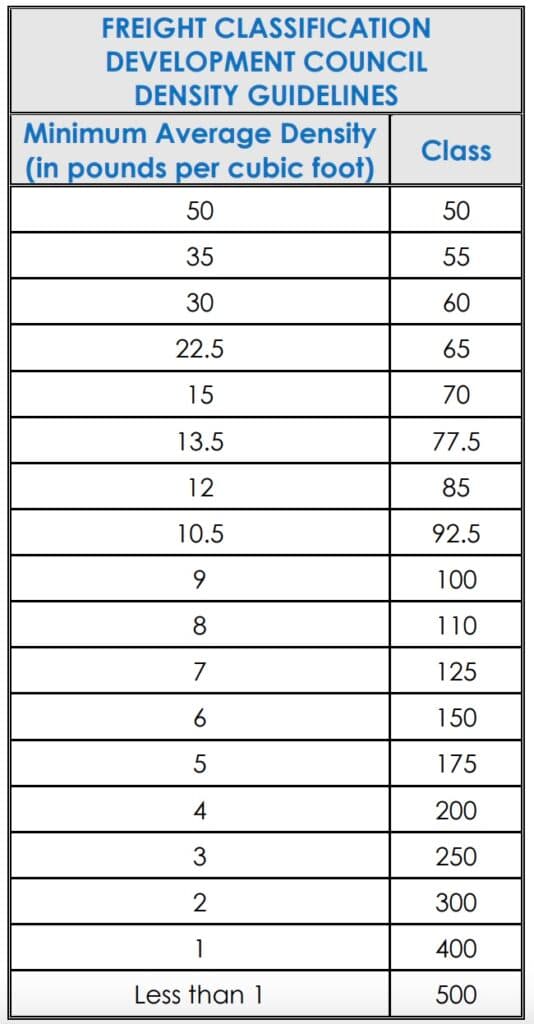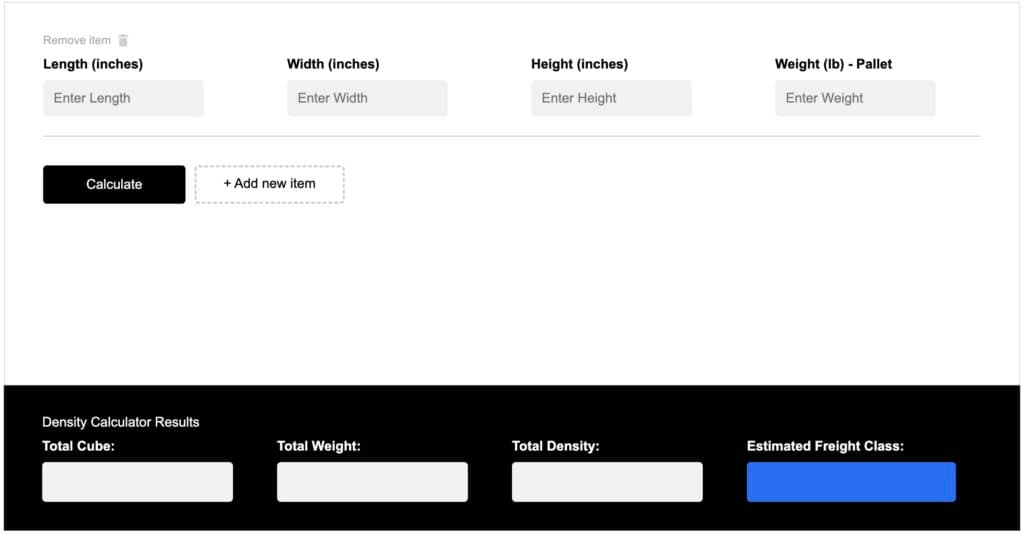
Before shipping goods, businesses need to determine their freight class. Why? So that they can figure out how much they’ll have to pay for shipping. With more and more goods shipped daily, it becomes essential to have some sort of standardization in types of cargo.
The freight class system conveniently provides carriers and shippers with a common language for determining freight costs and avoiding unnecessary disputes. Freight class helps maintain standardization and consistency in the supply chain. This article breaks down the ins and outs of classifying freight, how freight classification works and how to determine freight class for shipments.
What is a freight class?
Freight class is a common standardized freight pricing system in the shipping industry. It categorizes various commodities based on their characteristics like density, stowability, handling, and liability. These classes, ranging from Class 50 to Class 500, play a crucial role in determining the shipping rates and requirements for different types of cargo. The classification system ensures consistency and fairness in pricing across the logistics spectrum.
Some of the most common shipping problems arise from the difficulty of comprehending what LTL freight class to choose and put on Bills of Lading (BOL). Freight classes are defined by the National Motor Freight Traffic Association (NMFTA) and made available through the National Motor Freight Classification (NMFC).
The National Motor Freight Classification (NMFC) tariff is a system used to categorize freight, as defined by the National Motor Freight Traffic Association. Commodities are grouped into one of 18 classes, ranging from the lowest class of 50 (least expensive) to the highest class of 500 (most expensive). The classification is based on an evaluation of transportation characteristics, including density, stowability, handling, and liability/value. Here is a list of all 18 freight classes based on weight range:

Source: https://nmfta.org
Why is freight class important?
Your freight class is needed to get a rate quote or create a Bill of Lading. When your shipment is inspected, a missing or incorrect classification may add fees to your shipment costs.
How do you determine freight class?
Determining freight classification accurately is crucial to optimize shipping costs and ensure that logistics operations work smoothly. Here is a step-by-step guide on how to determine the freight class for shipments:
Step 1: Weigh the freight
Begin by gathering detailed information on all shipments, including their weight, dimensions, packaging types, and contents. Measuring weight accurately is essential for determining freight classification. Shippers need to use scales to obtain precise weight readings for each package.
Density refers to the weight of a commodity measured in pounds per cubic foot. Shippers can compute the density of the shipment by dividing its weight by its volume. Density plays a significant role in freight classification, with higher density often resulting in lower freight classes. Managers and shippers can also use a freight density calculator to determine their freight class.
To use a Shipping Density Calculator: 1) enter the dimensions per handling unit, 2) enter the weight per handling unit, 3) the system will populate: calculated density and total cubic feet.

Step 3: Assess handling & stowability
Figure out if the freight requires special handling and care. Additionally, check the stowability of the shipment. Can it be easily stowed away or kept away in a container or pallet? Are there special requirements when moving the shipment or products? For instance, if shipping hazmat or hazardous materials, shippers must handle the pallet carefully.
Items that are cumbersome to handle or require special care may be classified at a higher freight class, potentially impacting shipping costs. To accurately assess the appropriate classification based on handling and stowability, evaluate factors such as fragility, shape, and special handling requirements.
Step 4: Choose the correct freight class according to the national motor freight traffic classification
Refer to the National Motor Freight Traffic Association’s (NMFTA) class-based grading system, which categorizes commodities into 18 classes ranging from 50 to 500, (or just check the detailed list we shared in this article above). Match the shipment with the appropriate class and ensure that the classification is accurate.
Step 5: Consult with freight experts
Despite following all these steps, shippers may find it confusing to classify freight accurately. When uncertain or if needing assistance determining freight class, don’t hesitate to seek guidance from freight experts or carriers. These experts can help shippers make informed decisions about freight classification.
Common mistakes to avoid when determining freight class
When it comes to determining freight class it can be highly complex and intricate, especially when it comes to LTL shipping, which involves different loads and destinations. Errors in determining freight class classification can impact costs and delay shipments. It is critical to recognize common errors in order to avoid costly mistakes. To help, here are some common errors to avoid when determining freight class.
Incorrect weights or dimensions: Accurate weightage is an important part of freight classification. Inaccuracies in this area can lead to misclassification, resulting in inflated shipping costs and strained carrier relations.
Errors in filing paperwork: Misclassifying freight or provisioning incorrect information in the paperwork can lead to severe delays and repercussions for the shipments. If paperwork has errors, shippers may experience administrative complications, pay fines, or face delayed processes.
Wrong class category: Not choosing the suitable class for cargo can also have costly results. Assigning a lower class to a higher class of cargo or the freight class wrong for a shipment can lead to high additional fees and delays, not to mention potential reclassification by carriers and inflated carrier costs.
Not using a freight class calculator: Failing to use tools like freight class calculators can leave room for errors in classification. These tools help businesses stay updated on the latest pricing and density adjustments, making it more straightforward to know if their classification is accurate. Utilizing these resources ensures accuracy and helps mitigate the risk of costly misclassifications.
Faulty BOL information: The BOL, or Bill of Lading, contains all information regarding freight class. Listing incorrect information on the BOL, such as inaccurate weights or dimensions, can lead to errors in classification and potential reclassification by carriers, causing delays and increased costs.
Strategies for optimizing freight class
Optimizing freight class is essential when it comes to LTL shipments. Less-than-truckload or other LTL freight class chart entails a variety of products being shipped on a single pallet. These do not all share liability and density values, nor do they necessarily require equal handling and stowing efforts, and therefore, must be priced differently. Optimizing freight class involves maintaining service levels while ensuring reduced costs.
Here are some strategies and best practices to consider when optimizing freight class:
Utilize packaging techniques: Use packaging techniques that increase density and reduce empty space in LTL shipments. Compact and efficient packaging helps lower the weight and density of the cargo, ensuring a lower freight class and corresponding lower costs.
Consolidate multiple shipments: Consolidating smaller shipments into larger packages allows for more economical loads. As the overall number of shipments is reduced, weight and the pounds per cubic density also fall, bringing down the freight class. This leads to lower handling and transportation costs per unit.
Optimize load configuration: Strategically arrange products within shipping containers or trailers to optimize space utilization and minimize wasted capacity. Efficient load configuration ensures maximum use of available space, reducing the need for higher freight classes due to unused volume.
Evaluate carrier performance: Assess and audit the service quality offered by partner LTL carriers regularly to ensure expectations of reliability and efficiency are met. Partner with reputable carriers to get the best service levels and most cost-effective solutions.
Leverage technology solutions: Using freight management software or systems can not only help with real-time visibility and freight tracking but can also help reduce freight classification via collaborative supply chain networks that connect shippers to relevant carrier partners and other stakeholders.
Selecting the right LTL as a shipper
Choosing the appropriate LTL (Less Than Truckload) solution is crucial for optimizing shipping efficiency and controlling costs. Here are key factors to consider in the selection process:
Assess shipping needs: Understand shipment volume, frequency, and special requirements.
Define service requirements: Determine desired transit times, tracking capabilities, and handling preferences.
Research LTL carriers: Explore carrier options, considering reputation, coverage area, and service offerings.
Review performance metrics: Analyze carriers’ on-time delivery rates, claims handling, and customer service.
Evaluate pricing: Compare rates, accessorial charges, and discounts to ensure competitive pricing.
Evaluate technologies: Assess carriers’ technology capabilities for shipment tracking and management.
Assess capabilities: Ensure carriers can handle the shipment size, weight, and special handling needs.
Review insurance coverage: Confirm carriers’ liability coverage aligns with the shipment’s value and risk.
Seek reviews: Gather customer feedback to gauge carrier reliability and satisfaction.
Negotiate terms: Negotiate contract terms, including rates, service levels, and payment terms.
Monitor performance: Monitor carrier performance and adjust as needed to maintain efficiency and cost-effectiveness.
Impact of freight class on shipping rates
Choosing the right freight class has a direct impact on shipping rates. Accurate classification ensures fair pricing and smoother logistics operations. Shippers must prioritize precise freight classification to optimize carrier selection and minimize shipping rates, ultimately driving efficiency and cost savings in their supply chain. Partners like Uber Freight can help businesses with all their LTL shipping needs. Connect with an Uber Freight expert today to optimize your freight class and derive cost benefits or start your LTL quote now and sign up on Uber Freight Shipping.
Sign up today